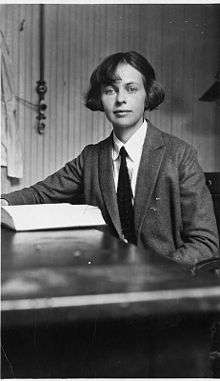Gertrude Van Wagenen
Gertrude L. Van Wagenen (1893 – February 8, 1978) was an American biologist. She was also a collector of anatomical illustrations and models.
Gertrude Van Wagenen | |
|---|---|
 Gertrude Van Wagenen, from the Science Service Records, Smithsonian Institution Archives. | |
| Born | 1893 |
| Died | February 8, 1978 (aged 84–85) |
| Nationality | American |
| Alma mater | Iowa State University University of Iowa |
| Known for | Endocrinology |
| Spouse(s) | Crawford Fairbanks Failey MD |
| Scientific career | |
| Fields | Biology |
| Thesis | The Coral Mussa Fragilis and Its Development (1920) |
Early life
Gertrude L. Van Wagenen was the daughter of Anthony Van Wagenen (1852–1937), a judge and lawyer in Sioux City, Iowa, and his wife Gertrude (née Louis). She completed undergraduate studies at Iowa State University in 1913, where she majored in zoology and was a member of the Beta Zeta chapter of the Kappa Kappa Gamma sorority.[1] For a few years after graduating, she taught in Ottumwa, Iowa, and endured a case of scarlet fever, with the quarantine it required.[2] In 1918, she collected corals, anemones, and medusae as part of the Barbados-Antigua Expedition, a group of University of Iowa graduate students and faculty studying the natural history of those islands.[3] Her doctoral dissertation at the University of Iowa was titled The Coral Mussa Fragilis and Its Development.[4]
Research
Van Wagenen was associate professor and lecturer at Yale School of Medicine, where she did pioneering work in the field of reproductive endocrinology.[5] In 1935, she established an influential early breeding colony of rhesus monkeys in Yale's Department of Obstetrics and Gynecology.[6] Over more than four decades, Gertrude van Wagenen amassed birth-to-death data on 1261 monkeys, including 600 live births, covering fifteen generations.[7] She and gynecologist John McLean Morris are considered the "discoverers" of morning-after contraception, working first with diethylstilbestrol (DES) to prevent pregnancy.[8][9][10] Van Wagenen and Morris reported their successes with monkeys and with women, respectively, at the 1966 annual meeting of the American Fertility Society.[11]
Her monographs included Embryology of the Ovary and Testis in Homo sapiens and Macaca mulatta (Yale University Press 1965), and Postnatal Development of the Ovary in Homo sapiens and Macaca mulatta and Induction of Ovulation in the Macaque (Yale University Press 1973, co-authored with Miriam E. Simpson).
Personal life
Gertrude Van Wagenen married Crawford Fairbanks Failey, M.D. (1900–1981); her husband had inherited wealth, which allowed her to travel.[12] In addition to her research, Van Wagenen enjoyed traveling and collecting medical illustrations and objects, including engravings, textbooks, models, and mannequins. She was also interested in art and cultural depictions of monkeys. On a trip to Japan in 1957, she found a book, Junichiro Itani's Japanese Monkeys in Takasakiyama (1954). She sent it to a colleague, who in turn arranged for it to be translated and published in English.[13] Van Wagenen died on February 8, 1978.[14] Her collections were left to the medical history library at Yale.[12]
References
- van Wagenen, Gertrude (December 1912). "Beta Zeta, Iowa State University". The Key. Columbus, Ohio: Kappa Kappa Gamma. 29 (4): 456. hdl:2027/mdp.39015075963077.
- . (March 1915). "Class News 1913". The Iowa Alumnus. 12. Iowa City: University of Iowa Alumni Association. p. 31.CS1 maint: numeric names: authors list (link)
- James, Lindsay; Simpson, Cynthia (December 2002). "University of Iowa Barbados-Antigua Expedition, April 23rd, 1918". Iowa City: University of Iowa Department of Geoscience. Archived from the original on 2015-04-25.
- van Wagenen, Gertrude (1920). The coral Mussa fragilis and its development (Ph.D. thesis). Iowa City: University of Iowa. OCLC 148209935.
- Rossiter, Margaret W. (1982). "Academic employment: protest and prestige". Women scientists in America: struggles and strategies to 1940. Baltimore: Johns Hopkins University Press. pp. 182, 185–186. ISBN 0-8018-2443-5.
- Fridman, Eman P. (2002). "History of medical primatology". In Nadler, Ronald D. (ed.). Medical primatology: history, biological foundations and applications. London: Taylor & Francis. p. 32. ISBN 0-415-27583-0.
- Johnsen, Dennis O.; Johnson, David K.; Whitney, Robert A. Jr. (2012). "History of the use of nonhuman primates in biomedical research". In Abee, Christian R.; Mansfield, Keith; Tardiff, Suzette; et al. (eds.). Nonhuman primates in biomedical research 1: biology and management (2nd ed.). London: Elsevier/Academic Press. p. 6. ISBN 978-0-12-381365-7.
- Kunjappu, Mary J. (June 2011). "Pioneering studies of the 'morning-after' pill". Yale Journal of Biology and Medicine. 84 (2): 109–111. PMC 3117403. PMID 21698041.
- Dutton, Diana Barbara; Preston, Thomas A.; Pfund, Nancy E. (1988). "Another use for DES: from pregnancy enhancer to pregnancy terminator". Worse than the disease: pitfalls of medical progress. Cambridge: Cambridge University Press. pp. 66–67, 405. ISBN 0-521-34023-3.
- Minkin, Mary Jane; Wright, Carol V. (2003). "Morning-after contraception". The Yale guide to women's reproductive health: from menarche to menopause. New Haven: Yale University Press. p. 116. ISBN 0-300-09820-0.
- Prescott, Heather Munro (2011). The morning after: a history of emergency contraception in the United States. New Brunswick, N.J.: Rutgers University Press. pp. 4, 19–20, 22–24, 27, 35, 37, 58–60, 132–133, 139. ISBN 978-0-8135-5162-3.
- "Other early collectors and donors". New Haven: Cushing/Whitney Medical Library, Medical Historical Library. 2010. Archived from the original on 23 June 2011. Retrieved 16 March 2013.
- Haraway, Donna (2001). "The biopolitics of a multicultural field". In Lederman, Muriel; Bartsch, Ingrid (eds.). The gender and science reader. London: Routledge. p. 253. ISBN 0-415-21357-6.
- "Deaths elsewhere: Gertrude van Wagenen". Toledo Blade. AP. February 10, 1978. p. 12.